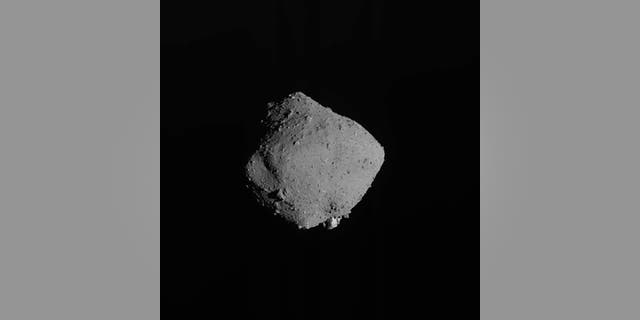world-regions Hayabusa2 air-and-space successfully released a small capsule on Saturday and sent it toward planet-earth” target=”_blank”>Earth< that could provide clues to the origin of the air-and-space” target=”_blank”>solar system<.
SPACECRAFT THAT SUCCESSFULLY ‘BOMBED’ AN ASTEROID IS CLOSE TO HOME WITH VALUABLE CARGO
“The capsule has been separated. Congratulations,” JAXA project manager Yuichi Tsuda said.
Hayabusa2 left the asteroid Ryugu, about 300 million kilometers (180 million miles) away, a year ago. After it released the capsule, it moved away from Earth to capture images of the capsule descending toward the planet as it set off on a new expedition to another distant asteroid.
About two hours later, JAXA said it had successfully rerouted Hayabusa2 for its new mission, as beaming staff exchanged fist and elbow touches at the agency’s command center in Sagamihara, near Tokyo.

This Nov. 13, 2019, file image released by the Japan Aerospace Exploration Agency (JAXA), shows asteroid Ryugu taken by Japan’s Hayabusa2 spacecraft. (JAXA via AP, File)
“We’ve successfully come this far, and when we fulfill our final mission to recover the capsule, it will be perfect,” mission manager Makoto Yoshikawa said from the command center during a livestreaming event.
People who gathered to watch the capsule’s separation at public viewing events across Japan cheered the success. ”I’m really glad that the capsule has been successfully released. My heart was beating fast when I was watching,” said Ichiro Ryoko, a 60-year-old computer engineer who watched at Tokyo Dome.
Hayabusa2′s return with the world’s first asteroid subsurface samples comes weeks after air-and-space OSIRIS-REx spacecraft made a successful touch-and-go grab of surface samples from asteroid Bennu. world-regions, meanwhile, announced this week that its air-and-space lander collected underground samples and sealed them within the spacecraft for their return to Earth, as space-developing nations compete in their missions.
In the early hours of Sunday, the capsule, protected by a heat shield, will briefly turn into a fireball as it reenters the atmosphere 120 kilometers (75 miles) above Earth. At about 10 kilometers (6 miles) aboveground, a parachute will open to slow its fall and beacon signals will be transmitted to indicate its location.
 Video
Video
JAXA staff have set up satellite dishes at several locations in the target area to receive the signals. They also will use a marine radar, technologies and helicopters to assist in the search and retrieval of the pan-shaped capsule.
Australian National University space rock expert Trevor Ireland, who is in Woomera for the arrival of the capsule, said he expected the Ryugu samples to be similar to the meteorite that fell in Australia near Murchison in Victoria state more than 50 years ago.
“The Murchison meteorite opened a window on the origin of organics on Earth because these rocks were found to contain simple amino acids as well as abundant water,” Ireland said. “We will examine whether Ryugu is a potential source of organic matter and water on Earth when the solar system was forming, and whether these still remain intact on the asteroid.”
Scientists say they believe the samples, especially ones taken from under the asteroid’s surface, contain valuable data unaffected by space radiation and other environment” target=”_blank”>environmental factors< during the 1½ years it spent near Ryugu after arriving there in June 2018.
In its first touchdown in February 2019, it collected surface dust samples. In a more challenging mission in July of that year, it collected underground samples from the asteroid for the first time in space history after landing in a crater that it created earlier by blasting the asteroid’s surface.
Asteroids, which orbit the sun but are much smaller than planets, are among the oldest objects in the solar system and therefore may help explain how Earth evolved.
Ryugu in Japanese means “Dragon Palace,” the name of a sea-bottom castle in a Japanese folk tale.

Leave A Comment
You must be logged in to post a comment.